- What is SPR?
- Why SPR?
- How SPR works
- Alto Instrument
- OpenSPR Instrument
- OpenSPR-XT Instrument
- OpenSPR Sensors
- OpenSPR Analysis Software
What is Surface Plasmon Resonance?
Surface plasmon resonance (SPR) is an optical effect that can be utilized to measure the binding of molecules in real-time without the use of labels. SPR instruments are primarily used to measure the binding kinetics and affinity of molecular interactions. SPR can be used, for example, to measure the binding between two proteins, a protein and an antibody, DNA and a protein, and many more. It helps researchers determine which molecules interact, why they interact, and how strongly they interact.
Why Surface Plasmon Resonance?
Surface plasmon resonance has become the golden standard for providing optimal quality kinetics, real time interaction data, and label-free analysis for a wide variety of applications. Ever since the inception of surface plasmon resonance, for more than two decades, it has becoming increasingly more affordable and accessible to researchers than ever before. One of the notable benefits of surface plasmon resonance is the value that SPR data can add to one's research.
How Surface Plasmon Resonance Works
The sensor chip is a gold film coated on a glass substrate that has been chemically modified to make it easier to immobilize one of the binding partners onto the surface of the sensor. The molecule that is immobilized is known as the ligand, and the molecule in solution is known as the analyte. The sensor chip is interface with the fluidic system through the use of a small flow cell, so that the analyte can be injected at different concentrations in a very repeatable manner.
Alto Instrument
The first ever DMF-powered SPR system
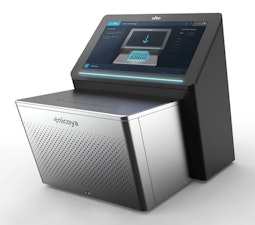
| Applications: | Compatible With: | |
|
Surface Chemistries: Carboxyl, NTA, Streptavidin, Biotin, Protein A, Thiol
OpenSPR Instrument
Obtain publication-quality binding kinetics & affinity data on your benchtop.
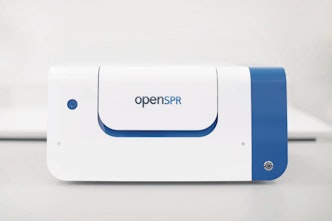
OpenSPR is the world's only benchtop surface plasmon resonance (SPR) instrument. It provides high quality, label-free interaction analysis for a fraction of the cost of existing solutions. Nicoya's unique nano-structured sensor surface uses localized SPR (LSPR) to deliver repeatable, highly sensitive kinetic data.
| Applications: | Compatible With: | |
|
|
OpenSPR-XT Instrument
Maximize your productivity with fully automated, 24/7 operation of our benchtop SPR.
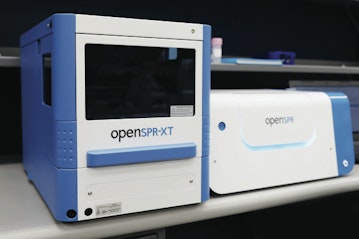
OpenSPR-XT is built with our cutting-edge and affordable nanotechnology biosensor platform. It has been seamlessly integrated with our robust autosampler system to allow for fully automated, 24/7 operation.
| Applications: | Compatible With: | |
|
|
OpenSPR Sensors
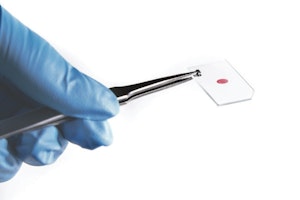 Tired of expensive surface plasmon resonance sensor chips? Nicoya's nanotechnology enabled sensors are manufactured to the highest quality to ensure consistent and repeatable measurements, at half of the price of traditional sensors. Achieve less than 2% CV on all critical optical properties. Nicoya sensors are stable in a variety of solvents, buffers and reagents. With high-quality and affordable OpenSPR Sensors, you have the freedom to run more experiments.
Tired of expensive surface plasmon resonance sensor chips? Nicoya's nanotechnology enabled sensors are manufactured to the highest quality to ensure consistent and repeatable measurements, at half of the price of traditional sensors. Achieve less than 2% CV on all critical optical properties. Nicoya sensors are stable in a variety of solvents, buffers and reagents. With high-quality and affordable OpenSPR Sensors, you have the freedom to run more experiments.
*Compatible with OpenSPR and OpenSPR-XT instruments
High Sensitivity Sensors
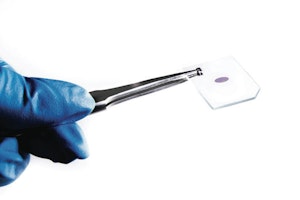 High Sensitivity Sensors provide increased sensitivity for your toughest SPR applications. The increased localized sensitivity is particularly advantageous for small molecule analysis, and can also be used to enhance the signals of other larger biomolecules.
High Sensitivity Sensors provide increased sensitivity for your toughest SPR applications. The increased localized sensitivity is particularly advantageous for small molecule analysis, and can also be used to enhance the signals of other larger biomolecules.
OpenSPR Software

The OpenSPR software is for exclusive use with OpenSPR instruments. Designed custom for researchers, it allows for control of the instrument and fast real-time data acquisition. The OpenSPR software is included with the purchase of an OpenSPR Starter Kit.
- Intuitive and easy-to-use
- Guided setup, cleaning and shutdown procedures
- Ligand immobilization wizards
- Full test automation (OpenSPR-XT)
- Ability to create, save and load test templates (OpenSPR-XT)
- CSV export for flexible data processing options
- TraceDrawer export for quick and easy analysis
TraceDrawer Software
TraceDrawer is the ultimate solution for real-time interaction data handling and integrates seamlessly with data produced from the OpenSPR. It can also be used with data generated from any real-time analysis tool once the data is in the appropriate format (.txt or .csv file formats). TraceDrawer can be used to post-process data (subtract references, cut, move, combine data from several experiments), evaluate kinetic constants (ka and kd), evaluate affinity constants and EC50, create reports and produce publishable figures.
